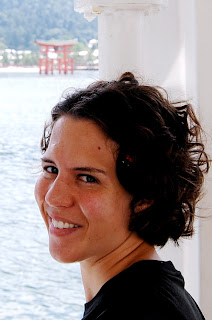
Hagi's pottery is known for its fine glazes and pastel colors.
Summer break's over, and it's time to get caught up reporting on all the fun we've been having. Teachers in Japan do have to work in the summer even when the students are on break, but we took a few vacation days to make a couple of trips over long weekends.



I expected something grander, to be honest. This is it? Weren't the samurai an elite class of warriors? Maybe if I knew more about Japanese history I would have appreciated this more... but I felt a little let down.

Want to see a look of pure terror? Click on this photo above. Joe snapped that right after a hawk swooped within inches of my head to snap up a piece of bread.


It was chewy. And salty. And fishy. I proudly finished it. But I wasn't about to eat another one.
Then we settled in for sunset and enjoyed the sea view for a while.
First up: Hagi City, Yamaguchi Prefecture (Western Japan).
Hagi is a sleepy little town on the Japan Sea famous for its prized pottery (hagi-yaki). It's also a historically significant place, having played a key role in the overthrow of Shogun rulers that led to the end of the feudal era and the modernization of Japan.
Many samurai warriors used to live in Hagi, and some of their homes still exist. Walking through the streets of Hagi's old Samurai quarter, you can get a feel for what this place looked like hundreds of years ago. White stucco walls line the streets, creating a border over which you can spy traditional wooden houses. Unfortunately I apparently never took pictures of the walls, but here's one from ETripTips.
Here are a couple interesting structures we passed along the way.

Meirin-kan school
This preserved school building, founded in 1718, originally served gifted students who were meant to improve the country. This building today is used as part of an elementary school.
After checking out the castle ruins — today just the stone foundation remains — we peered into the moat and saw a large collection of carp. Joe pitched them a few potato chips and within 2.3 seconds we had attracted the attention of every living creature within the moat. Literally dozens of turtles came paddling up, little heads bobbing out of the water, hoping for a handout. I had never seen so many turtles before.
From there we went to check out an old samurai house.

This place housed samurai foot soldiers belonging to the Asa Mori Clan. It's really just a simple, long rectangular structure with tatami room after tatami room and the same kind of sliding doors we have in our apartment.

I expected something grander, to be honest. This is it? Weren't the samurai an elite class of warriors? Maybe if I knew more about Japanese history I would have appreciated this more... but I felt a little let down.
We rented some bicycles and rode around town, enjoying the atmosphere of the old streets, dropping by the beach and visiting a few temples.
As evening approached, Joe suggested we ride our bikes out to Mt. Kasayama, a small extinct volcano, and watch the sunset over the Japan Sea. Judging from the map, it seemed to be just a couple kilometers, so off we set.
At the base of the mountain we stumbled across Myojin Pond, and this turned out to be the most interesting place we encountered in Hagi. Imagine my surprise when I looked into the waters and saw stingrays gliding just below the surface. It turns out this pond was salt-water, drawing water from underground channels connected to the sea.
I watched as an old man alternately threw chunks of bread into the water for the fish and into the air to feed dozens of hawks that circled over the pond.
The hawks would swoop down and snatch the bread right out of the air with their talons. Of course, this was something I could not resist, so we bought a bag of bread chunks from a road-side vendor and joined in the fun.

Want to see a look of pure terror? Click on this photo above. Joe snapped that right after a hawk swooped within inches of my head to snap up a piece of bread.
Once our bread was exhausted, I crossed the street to nose around a little restaurant where a lady had hung some squid out to dry.
She was grilling some sea snails in green shells. Riding some adrenaline after nearly getting my skull cracked by a rogue hawk, I decided to buy one and test it out. How was it? Let Joe's pictures tell the story.
Preparing to eat strange green snail. With a happy face!

Chewing...

Yeahhh....
Once fortified on snail, we began plodding up Mt. Kasayama. I should mention, by the way, that this "couple kilometer" trek had in fact turned out to be at least three times that long, and by the time we'd heaved our bicycles to the peak we were both bathing in our own sweat.
It was pretty, though more clouds began rolling in as the sun sank lower, obscuring the view. We finally decided to book it back down the mountain before the sun fully set rather than make the descent in the pitch darkness.
Heading back to the hostel, we spent a sticky hot night in dorm rooms filled with hyper high school students visiting town for sports matches the next day. By morning we were more than ready to start the next leg of our trip — on to the little mountain town of Tsuwano.
















